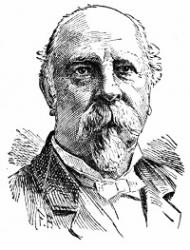Planning worship?
Check out our sister site, ZeteoSearch.org,
for 20+ additional resources related to your search.
- |
User Links
Person Results
Lydia Baxter

1809 - 1874 Author of "Mirad al Salvador Jesús" in Celebremos Su Gloria Baxter, Lydia, an American Baptist, was b. at Petersburg, N. York, Sep. 2, 1800, married to Mr. Baxter, and d. in N. Y. June 22, 1874. In addition to her Gems by the Wayside, 1855, Mrs. Baxter contributed many hymns to collections for Sunday Schools, and Evangelistic Services. Of these, the following are the best known:—
1. Cast thy net again, my brother. Patient toil. Given in the Royal Diadem, N. Y., 1873.
2. Go, work in my vineyard. Duty. Also given in the Royal Diadem, 1873, and Mr. Sankey's S. & Solos, No. 4.
3. I'm kneeling, Lord, at mercy's gate. Lent. In Coronation Hymns, &c, N. Y., 1879.
4. I'm weary, I'm fainting, my day's work is done. Longing for rest. Royal Diadem. 1873.
5. In the fadeless spring-time. Heavenly Reunion. In the Royal Diadem, 1873, I. D. Sankey's S. S. & Solos, No. 256, and others. It was written for Mr. H. P. Main in 1872.
6. One by one we cross the river. Death. In Songs of Salvation, N. Y., 1870, I. D. Sankey's S. S. & Solos, No. 357, &c. It dates cir. 1866.
7. Take the name of Jesus with you. Name of Jesus. Written late in 1870, or early in 1871, for W. H. Doane, and pub. in Pure Gold, 1871. It is No. 148 of I. D. Sankey's S. S. & Solos.
8. The Master is coming. Invitation. In Songs of Salvation, 1870, No. 38.
9. There is a gate that stands ajar. Mercy. In New Hallowed Songs, and also the Gospel Songs of P. Bliss, 1874. It was written for S. J. Vail about 1872. It has attained to some popularity. It is given in Mr. Sankey's S. & Solos, No. 2.
-John Julian, Dictionary of Hymnology (1907)
Lydia Baxter
S. J. Vail
1818 - 1883 Person Name: Silas J. Vail Composer of "[Mirad al Salvador Jesús]" in El Nuevo Himnario Popular (Edicion Revisada y Corregida) In his youth Silas Jones Vail learned the hatter's trade at Danbury, Ct. While still a young man, he went to New York and took employment in the fashionable hat store of William H. Beebe. Later he established himself in business as a hatter at 118 Fulton Street, where he was for many years successful. But the conditions of trade changed, and he could not change with them. After his failure in 1869 or 1870 he devoted his entire time and attention to music. He was the writer of much popular music for use in churches and Sunday schools. Pieces of music entitled "Scatter Seeds of Kindness," "Gates Ajar," "Close to Thee," "We Shall Sleep, but not Forever," and "Nothing but Leaves" were known to all church attendants twenty years ago. Fanny Crosby, the blind authoress, wrote expressly for him many of the verses he set to music.
--Vail, Henry H. (Henry Hobart). Genealogy of some of the Vail family descended from Jeremiah Vail at Salem, Mass., 1639, p. 234.
S. J. Vail
Henry Godden Jackson

1838 - 1914 Person Name: H. G. Jackson Author of "Mirad Al Salvador Jesús" in El Nuevo Himnario Popular (Edicion Revisada y Corregida) Born: January 1, 1838, Manchester, Indiana.
Died: November 12, 1914.
A Methodist minister, Jackson and his wife Alice spent many years as missionaries in Buenos Aires, Argentina. Upon their return to America, they lived in the River Forest/Oak Park area of Chicago, Illinois.
--www.hymntime.com/tch
Henry Godden Jackson
Johann Sebastian Bach

1685 - 1750 Person Name: J. S. Bach, 1685-1750 Harmonizer of "ACH GOTT UND HERR" in Cántico Nuevo Johann Sebastian Bach was born at Eisenach into a musical family and in a town steeped in Reformation history, he received early musical training from his father and older brother, and elementary education in the classical school Luther had earlier attended.
Throughout his life he made extraordinary efforts to learn from other musicians. At 15 he walked to Lüneburg to work as a chorister and study at the convent school of St. Michael. From there he walked 30 miles to Hamburg to hear Johann Reinken, and 60 miles to Celle to become familiar with French composition and performance traditions. Once he obtained a month's leave from his job to hear Buxtehude, but stayed nearly four months. He arranged compositions from Vivaldi and other Italian masters. His own compositions spanned almost every musical form then known (Opera was the notable exception).
In his own time, Bach was highly regarded as organist and teacher, his compositions being circulated as models of contrapuntal technique. Four of his children achieved careers as composers; Haydn, Mozart, Beethoven, Mendelssohn, Schumann, Brahms, and Chopin are only a few of the best known of the musicians that confessed a major debt to Bach's work in their own musical development. Mendelssohn began re-introducing Bach's music into the concert repertoire, where it has come to attract admiration and even veneration for its own sake.
After 20 years of successful work in several posts, Bach became cantor of the Thomas-schule in Leipzig, and remained there for the remaining 27 years of his life, concentrating on church music for the Lutheran service: over 200 cantatas, four passion settings, a Mass, and hundreds of chorale settings, harmonizations, preludes, and arrangements. He edited the tunes for Schemelli's Musicalisches Gesangbuch, contributing 16 original tunes. His choral harmonizations remain a staple for studies of composition and harmony. Additional melodies from his works have been adapted as hymn tunes.
--John Julian, Dictionary of Hymnology (1907)
Johann Sebastian Bach


 My Starred Hymns
My Starred Hymns


